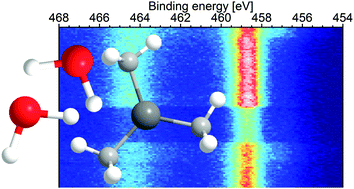In situ XPS analysis of the atomic layer deposition of aluminium oxide on titanium dioxide
Abstract
Ultra-thin aluminium oxide was grown on a rutile titanium dioxide surface by atomic layer deposition using trimethylaluminium and water precursors. This process, carried out using realistic temperatures and pressures (1 mbar, 450 K), was monitored in situ using near-ambient pressure X-ray photoelectron spectroscopy (NAP-XPS). This provides insight into the surface chemistry at the interface between the two oxide layers – specifically the reduction of titanium atoms from Ti4+ to Ti3+ upon dosing of trimethylaluminium. These defect states become locked into the heterojunction's interface, with implications to its electronic structure, and can act as an indicator as to when complete coverage of the rutile substrate is achieved.



 Please wait while we load your content...
Please wait while we load your content...